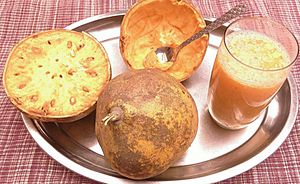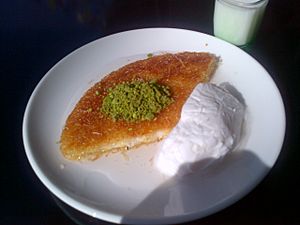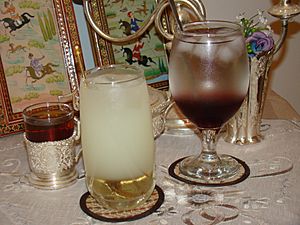Sharbat facts for kids
Sharbat is a sweet, cool drink popular in many countries. These include Iran, Turkey, South Asia, and the Balkans. It is made from fruits or flower petals.
Sharbat is like a sweet syrup. You can drink it as is, or mix it with water. It is usually served chilled.
Some popular sharbat flavors come from basil seeds, rose water, fresh rose petals, sandalwood, bael fruit, hibiscus, lemon, orange, mango, pineapple, falsa berries, and chia seeds.
Sharbat is a common drink in homes across Iran, Turkey, Bosnia, the Arab world, Afghanistan, Pakistan, Sri Lanka, Bangladesh, and India. Many Muslims enjoy drinking it when they break their daily fast during Ramadan.
In South India, a similar drink called sarbbath is popular. It is made in places like Kerala, Tamil Nadu, and Andhra Pradesh. This version uses a special syrup from Indian sarsaparilla and lemon. It is mixed with milk or soda water.
In Indonesia, especially Java, there is a drink called serbat. It is often found during Ramadan. A popular type is serbat blewah, made with cold water, syrup, and shredded cantaloupe.
Contents
What's in a Name?

The word sharbat comes from the Persian word sharbat. This means "a drink of sugar and water." It originally came from the Arabic word shariba, meaning "to drink."
Over time, the Arabic word sharāb started to mean "alcoholic drink." So, the word sharbāt and its Persian and Turkish forms, sharbat and şerbet, began to mean a sweet, non-alcoholic drink.
A Sweet History
Many people believe that sharbats first came from Iran (ancient Persia). Old books mention different syrups. For example, the 11th-century book Canon of Medicine by Avicenna lists several. In the 12th century, the Persian book Zakhireye Khwarazmshahi by Ismail Gorgani describes many types of sharbats in Iran.
Europeans first heard about sharbat from the Ottoman Turks. The Italian word sorbetto came from this, which then became sorbet in French. In the 1600s, England started bringing in "sherbet powders." These were made from dried fruit and flowers mixed with sugar. Today, sherbet powder is still popular in the UK.
When Europeans learned how to freeze sharbat, they started making sorbet. They added fruit juices and flavors to a frozen sugar syrup. In the US, sherbet often meant a frozen dessert with milk.
Traditionally, sharbat was made with cane juice. Today, it is often made at home with sugar and water. Sometimes, lime is added for better taste and texture. Honey is also a common sweetener. Sharbat comes in many flavors. These include lemon, pomegranate, quince, strawberry, cherry, orange, rose, and tamarind.
Sharbat in India
Sharbat came to India in the 16th century. The Mughals brought it. Emperor Babur made it popular. He would often have ice brought from the Himalayas to make cool, refreshing drinks.
Delicious Sharbat Flavors
There are many different kinds of sharbat. Each has its own special taste.
Tamarind and Plum Sharbat
Tamarind sharbat is a popular non-alcoholic drink in Muslim countries. It is often made during Ramadan. In Turkey, tamarind sharbat is called demirhindi şerbeti. It can be flavored with cloves, cardamom, fresh ginger, cinnamon, honey, sage, and dried linden flowers. In Urdu, tamarind is called imli. It is often mixed with dried plums (aaloo bukhara).
Almond Sharbat
Almond sharbat likely came from Persia. It can be spiced with cardamom and kewra. Another type of almond sharbat is made with milk and saffron. Sometimes, musk melon seeds are added.
Fruit and Flower Sharbats

Bael ka sharbat is made from wood apple. It can be flavored with salt, pepper, and mentha, or just sugar and lemon juice. It is very popular in India.
Another Indian sharbat uses powdered sandalwood (chandan) and sugared milk. Phalsa berries are also used to make some South Asian sharbets. Some sour sharbat types use citrus fruits, tamarind, or aamla berries. An Indian lemonade called nimbu pani is made with fresh lemon or lime juice. It can have flavors like ginger, mint, saffron, or black pepper.
Vetiver Sharbat
Vetiver sharbat, or khus syrup, is made by adding khus essence to sugar and water. This essence comes from the roots of vetiver grass. Khus sharbat can flavor milkshakes, lassi (a yogurt drink), ice cream, and other mixed drinks. It can also be a dessert topping.
Rose Sharbat
The most common sharbat flavor is probably rose. Rose sharbat can be used as a topping for milk pudding called muhallebi. In Turkey, fresh rose petals are kneaded with a little citric acid or sugar to release their smell. This petal mix is called gül mayası. It is added to a base of sugar and water to make rose sharbat. This can flavor desserts like muhallebi, cookies, and cakes.
Sharbat in the Ottoman Empire

In the Middle Ages, many Ottoman Muslims did not drink alcohol. This made sherbet very popular. Sherbet could be in three forms: syrups called şurup, pastes called çevirme, and tablets. Ottoman candy makers would create strong flavors from fresh ingredients. These could then be mixed with water to make sherbet.
Today, making sherbet has become less common. But in some parts of Turkey, syrups are still made. Pastes are rare and found only in special shops. Tablets were also special, made only by professional candy makers. To make tablets, fruit juices and oils like rose or cinnamon were added to boiling sugar water. This mixture was stirred until the sugar started to crystallize. Spices, ground nuts, and herbs could be added. The mix was then poured onto a marble slab to set.
In the 19th century, a writer named Isaac Edrehi wrote about two drinks: sherbet and khoshâb. Sherbet was slightly sour and made from fresh fruit juices like lemon, quince, orange, or cherry. Khoshâb was a sweet drink, often served at the end of meals. It was made from preserved fruits or syrups.
The Ottoman writer Evliya Çelebi wrote about khoshâb as "a kind of sherbet." He said it was made from the juice of excellent fruits. These included apricots, plums, pears, mulberries, grapes, and peaches. He also mentioned that khoshâb was flavored with "amber and musk." He described other sherbet shops with many cups filled with sherbet made from rhubarb, roses, lemons, and grapes.
A 15th-century Ottoman poem tells how the Islamic prophet Muhammad's mother was given a glass of sherbet while she was in labor. Today, when a woman in Anatolia gives birth, it is still a tradition to offer a hot sherbet called lohusa şerbeti to guests.
Common sharbat flavors include tamarind, pomegranate, black mulberry, sour grape, licorice, morello cherry, and rose. One version uses fresh purple wisteria flowers. The petals are soaked in water, strained, and then mixed with sugar.
A simple sherbet of lemon, citric acid, and water is called nişan şerbeti or "betrothal sherbet" in Turkish. It is traditionally served at engagement ceremonies. Some lemon sherbets can also be flavored with honey and cloves. A similar sherbet with cloves and lemon juice can be made with fresh peaches. Green apple and cinnamon is another flavor mix. One recipe for "Ottoman sherbet" uses sugared sour cherries, dried plums, golden raisins, fresh ginger, cloves, and cinnamon sticks, all simmered together.



